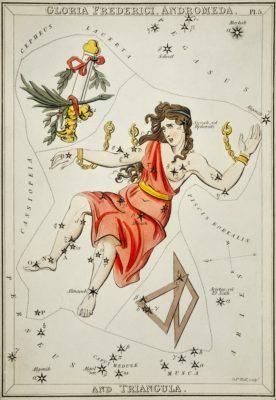Please read part 1 of The Roving “I” before this piece. It’s important to understand how the angles operate before tackling angle contacts and positions.
The tightrope walk between Ascendant and Descendant can be tricky. Ascendant/Descendant contacts are powerful. When this angle is touched by another person’s planet, we can feel as though we are finally ‘found’; this  person understands us and appreciates us for who we are. He/she seems to see the deepest part of the inner me, the ideal partner. Alas, this is also the area where we have blind spots, and where we assume too much. Inevitably, hidden and unconscious, yet-to-be-developed areas of the Asc/Desc axis come to light through the relationship. When there are planet/angle contacts it feels like “fate,” but there is also a tidal pull towards what may be difficult (and rarely, but occasionally, dangerous) psychological waters. We may or may not be prepared to navigate them, with the current partner or any other. Lack of development or lack of balance of the Ascendant/Descendant often contributes greatly to continuing relationship difficulties. An over-emphasis on one or the other end of the axis, either natally or via synastry, is certain to rock the relationship boat.
person understands us and appreciates us for who we are. He/she seems to see the deepest part of the inner me, the ideal partner. Alas, this is also the area where we have blind spots, and where we assume too much. Inevitably, hidden and unconscious, yet-to-be-developed areas of the Asc/Desc axis come to light through the relationship. When there are planet/angle contacts it feels like “fate,” but there is also a tidal pull towards what may be difficult (and rarely, but occasionally, dangerous) psychological waters. We may or may not be prepared to navigate them, with the current partner or any other. Lack of development or lack of balance of the Ascendant/Descendant often contributes greatly to continuing relationship difficulties. An over-emphasis on one or the other end of the axis, either natally or via synastry, is certain to rock the relationship boat.
A crucial element of examining relationship is to look at the progressed angles. They will tell you a great deal about the current state of affairs. Depending on what method you use to progress the chart, the angle moves at roughly one degree per year. Look to see if the progressed angle has recently changed signs–there will be a huge shift in perceived identity and relationship needs, and it’s often a rocky patch when one half of a couple goes through this phase. Also, look for progressed angles conjuncting progressed planets because the need to embody that planet will be powerful. Transits of the outer planets to progressed angles will also be deeply felt. Pluto often awakens primal dissatisfaction and the need to be reborn in some way, often through sex. Neptune may not only awaken longing, but also be accompanied by other-worldly experiences which change one’s perception of one’s self and one’s place in the scheme of things. Uranus will often spark a surprising about-face, or engender the need to ‘cut and run.’ It doesn’t matter which end of the angle is affected, though sometimes contact with the Descendant will bring the experience through a partner (i.e., Uranus conjunct Desc, my partner leaves me). In this case the partner is acting out the client’s unspoken need.
Combining basic relationship needs, as indicated in the natal charts, with currently emphasized needs will give a more accurate picture of the client’s relationship sensibility right now. For example, you might believe that you’re dealing with an earthy Capricorn Mars, but if that Mars has progressed into Aquarius, and furthermore is conjunct the progressed Descendant, he may be wanting to throw that ambitious earth energy to the wind, leave his steady Cancer girlfriend and go looking for partners who represent the free-wheeling and freedom-loving Aquarian archetype. He will find himself, perhaps to his own distress and surprise, attracted to women who love him and leave him, which will cause him to examine his own innate desires for solidity and security. Or he may fall for an intellectual, who will teach him that there is more to life than the goals he sets for himself. The years where Mars is conjunct the Descendant within one degree will be the crucial ones for change, but the Capricorn Mars will continue to have Aquarian experiences that help it expand its understanding of it’s own motives. The natal chart energy is the base we return to after our explorations in understanding, but progressions tell us what qualities we need to develop to move on and mature.
Examining the angles and the position of their rulers will give us a great amount of further detail regarding relationship behaviour. The positioning of the ruler gives us another layer of meaning. A person with the Descendant ruler in the first house will identify themselves as a partner, and be more partner-oriented than one with the Ascendant ruler in the 1st house, which is more independent. The Descendant ruler in the second house may give us someone who values partnership above all, or may depend on the partner for a sense of being valued. A person with the Descendant ruler in the eighth house may be attracted to partners who are overtly sexual, or who will provide the kind of intense, Plutonian, turn your soul inside out relationship experience. For further information, look where the eighth house ruler is placed. If it is conjunct an angle, it will show the area where that kind of transformative experience is sought: if conjunct the Descendant, a sexual partnership is crucial, no matter what else the chart says. If conjunct the 10th, the transformative experiences will be found through work; if the IC, the home and family. If the Ascendant, that person may constantly invent crises where they can reinvent themselves. Because we are dealing with the ruler of the 8th, all of these crises may be triggered by intense partnerships of all kinds.
In synastry, there are many elements to consider, but it’s good to remember that the angles are extremely alive and act as gateways to our sense of identity. They are highly sensitive points where experience is made conscious and available for our growth. A full picture of relationship orientation cannot be made without them.
In part 3 we explore the signs on the axis, the behaviours that may need to be outgrown and pitfalls that may occur.
The Shadow in Synastry: The Roving “I” (part 3). See also, “The Inner Script.”

In your fifth paragraph you state, “The positioning of the ruler gives us another layer of meaning. A person with the Descendant ruler in the first house will identify themselves as a partner, and be more partner-oriented than one with the Ascendant ruler in the 1st house,” is this ruler within the synastry chart? I am assuming it is.